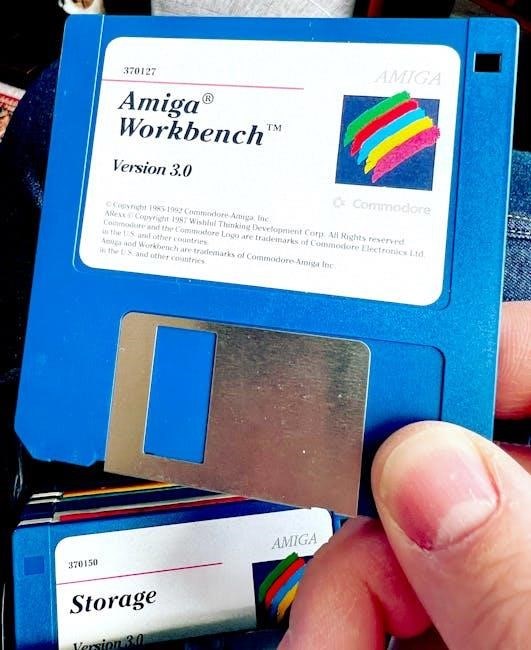
REAPER is a powerful, flexible, and user-friendly digital audio workstation for recording, editing, and mixing audio. Designed for musicians and producers, it offers customizable workflows, supports various audio formats, and provides advanced MIDI editing capabilities, making it an efficient tool for both beginners and professionals. Its lightweight design ensures optimal performance across different operating systems and project sizes.
1.1 What is REAPER?
REAPER (Rapid Environment for Audio Production, Engineering, and Recording) is a digital audio workstation (DAW) designed for recording, editing, and mixing audio. Known for its lightweight and flexible nature, it supports various audio formats and MIDI editing. REAPER is highly customizable, allowing users to tailor workflows to their needs. It is compatible with multiple operating systems and is widely used by professionals and hobbyists alike for its efficiency and versatility. The software also offers advanced features like FX chains, screensets, and snapshots, making it a powerful tool for audio production and post-production tasks.
1.2 Key Features of REAPER
REAPER offers a wide range of features tailored for professional audio production. It supports multi-track recording, non-destructive editing, and real-time effects processing. Users can customize the interface, actions, and workflows to suit their needs. The software includes advanced tools for MIDI recording and editing, as well as support for virtual instruments and plug-ins. REAPER also features FX chains, snapshots, and screensets for efficient project management. Its compatibility with various audio formats and operating systems makes it versatile for both music production and post-production tasks. The lightweight design ensures smooth performance, even with complex projects.
1.3 Why Use REAPER?
REAPER stands out for its flexibility, efficiency, and affordability. It offers a user-friendly interface with deep customization options, making it accessible to both hobbyists and professionals. The software is lightweight yet powerful, ensuring smooth performance on various systems. REAPER supports a wide range of audio formats and plugins, enabling versatile production workflows. Its robust feature set, including advanced MIDI and audio editing tools, makes it ideal for music production, podcasting, and post-production. With regular updates and a supportive community, REAPER provides a cost-effective solution for achieving high-quality audio results without compromising on functionality or creativity.

System Requirements and Installation
REAPER supports Windows, macOS, and Linux, requiring minimal system resources. Installation is straightforward across operating systems, ensuring quick access to its robust audio production capabilities.
2.1 System Requirements for REAPER
REAPER operates efficiently on Windows (7 or later), macOS (10.9 or higher), and Linux. It requires a 64-bit processor, 2GB RAM, and 100MB disk space; While a modern CPU enhances performance, REAPER’s lightweight design ensures compatibility with older systems. Audio interfaces with ASIO, Core Audio, or ALSA drivers are supported for optimal recording and playback. No additional hardware is mandatory, making REAPER accessible for diverse setups. This flexibility allows musicians and producers to utilize REAPER across various environments without compromising functionality or performance.
2.2 Downloading REAPER
REAPER can be downloaded from the official Cockos website. Visit https://www.reaper.fm and select the appropriate version for your operating system (Windows, macOS, or Linux). Choose between the 64-bit or 32-bit installer based on your system requirements. The download is approximately 20MB, ensuring a quick and seamless process. Once downloaded, run the installer and follow the prompts to complete the installation. Additionally, the website offers a portable ZIP version for flexibility. Always verify the download source to ensure authenticity and security.
2.3 Installation Steps
Once downloaded, run the REAPER installer and follow the on-screen instructions. Choose the installation location, typically in the Program Files directory. Select additional components like the REAPER User Guide or language packs if desired. Click Install to begin the process, which takes a few minutes. After installation, launch REAPER and configure your audio settings via Options > Preferences. You can also create a desktop shortcut for easy access. For macOS, drag the REAPER app to the Applications folder. Linux users may need to extract the portable ZIP file and run the executable.
2.4 Activating REAPER
To activate REAPER, launch the software and select Help > Enter License Key from the menu. Enter your purchased license key in the provided field and click OK. For portable licenses, place the reaper-license.rld file in the same directory as the REAPER executable. A 60-day evaluation period is available for new users. After expiration, purchase a license from the official website. Ensure internet access for activation. Refer to the REAPER User Guide under Help > Open Manual for troubleshooting activation issues.

Getting Started with REAPER
REAPER offers a user-friendly interface for audio production. Start by setting up tracks, exploring the timeline, and customizing your workflow to suit your creative needs.
3.1 Interface Overview
REAPER’s interface is designed for efficiency and customization, featuring a clean layout that adapts to your workflow. The main window includes the toolbar, track control panels, and the arrange view, where you can arrange and edit audio and MIDI. The transport bar provides controls for playback, recording, and navigation. Below, the track area displays waveform visuals and MIDI data. Additional panels like the MIDI editor, mixer, and effects rack can be docked or floated for flexibility. Customize the appearance and layout using themes, docking options, and screensets to tailor the workspace to your needs. This adaptability makes REAPER intuitive for both beginners and professionals.
3.2 Setting Up Your Audio Interface
Setting up your audio interface in REAPER ensures proper input and output configuration for recording and playback. Connect your audio hardware and open REAPER’s preferences to select your device under ‘Audio’ settings. Choose the correct ASIO, Core Audio, or DirectSound driver. Adjust buffer sizes for optimal performance. Enable monitoring to hear live inputs without latency. Test inputs by recording a track and outputs by playing back audio. Proper setup ensures clear sound and smooth operation, allowing you to focus on creating music without technical issues.
3.3 Configuring MIDI Devices
Configuring MIDI devices in REAPER allows seamless integration with controllers, synthesizers, and other MIDI hardware. Open REAPER’s preferences and navigate to the MIDI settings. Select your MIDI driver, such as MME, DirectMusic, or ASIO MIDI. Add your MIDI devices by clicking “Add” and choosing the correct input/output ports. Enable MIDI input if needed and set up MIDI filters to block unwanted data. Assign MIDI controllers to REAPER actions or virtual instruments for enhanced workflow. Finally, test your setup by recording a MIDI track to ensure proper functionality. Proper MIDI configuration ensures accurate control and synchronization for your music production tasks.
Recording Audio
REAPER simplifies recording audio with intuitive tools for setting up tracks, enabling recording, and managing takes. Easily capture high-quality audio and organize it efficiently for further editing.
4.1 Setting Up Tracks
Setting up tracks in REAPER is straightforward. Create new tracks using Ctrl+T and choose mono or stereo configurations. Name tracks for clarity and arm them for recording by clicking the R button. Configure input settings by selecting your audio interface or virtual instrument. Adjust levels, pan, and other settings in the track header. Use the routing matrix to send audio to multiple destinations. Add track templates for quick setup of common configurations, such as drum kits or vocal tracks. Proper track setup ensures efficient workflow and clear organization for recording sessions.
4.2 Recording Basics
Recording in REAPER is intuitive and flexible. Begin by arming tracks using the R button in the track header. Select your input source from the track’s input dropdown menu. Use the transport bar to start recording with the Record button or press R. Enable the metronome or count-in for precise starts. Monitor levels in the meter to avoid clipping. Press Spacebar to stop recording. REAPER automatically creates a new take, allowing you to review and manage recordings efficiently. Use the undo feature (Ctrl+Z) to correct mistakes. This process ensures smooth and effective audio capture in your projects.
4.3 Managing Takes and Layers
Managing takes and layers in REAPER allows for efficient organization of recordings. A “take” is a single recording pass, while “layers” enable stacking multiple takes within a single track. Access takes via the context menu by right-clicking on a media item. Use the Take menu to cycle through or select specific takes. Layers provide non-destructive recording, letting you experiment without losing previous takes. Promote layers to separate tracks for independent editing. Use the comping tool to create a composite take from the best parts of multiple layers. Navigate takes seamlessly using the media item properties. This workflow enhances creativity and keeps your project organized, ensuring a smooth recording experience.

Editing Audio
REAPER offers flexible audio editing tools for precise manipulation. Perform non-linear edits, adjust timing, and use advanced features like elastic time and pitch shifting for professional results.
5.1 Basic Editing Techniques
REAPER provides essential tools for audio editing, including trimming, splitting, and crossfading clips. Users can perform non-destructive edits, allowing for flexible adjustments without altering the original file. The software supports time-stretching and pitch-shifting, enabling precise control over audio segments. Basic editing operations can be enhanced with keyboard shortcuts, streamlining the workflow. For beginners, REAPER’s intuitive interface makes it easy to navigate and apply fundamental edits. Real-time preview options ensure accuracy, while undo/redo functions provide a safety net for experimentation. These techniques form the foundation for more complex editing tasks, making REAPER a versatile tool for audio post-production and music creation.
5.2 Using the Arrange View
The Arrange View in REAPER is where you organize and arrange audio and MIDI clips to structure your project. This linear, timeline-based interface allows you to visually place and manipulate clips, enabling precise control over your composition. Use the mouse or keyboard shortcuts to move, resize, or split clips. The Arrange View also supports time-stretching, crossfading, and snapping for accurate placements. For clarity, tracks can be colored, labeled, and grouped. This view is essential for building and refining your project, making it easier to visualize and adjust the flow of your audio and MIDI elements effectively.
5.3 Advanced Editing Tools
REAPER offers advanced editing tools for precise audio manipulation. The multi-track editor allows for complex layering and synchronization, while spectral editing tools enable frequency-specific adjustments. Item grouping simplifies managing related clips, and time-stretching preserves pitch during tempo changes. Advanced crossfading options ensure smooth transitions, and batch processing streamlines repetitive tasks. These tools, combined with customizable actions, enhance efficiency and creativity, making REAPER a versatile choice for professional audio production and post-production workflows.

Working with MIDI
REAPER supports comprehensive MIDI recording, editing, and manipulation. It includes tools for creating and arranging virtual instruments, adjusting MIDI data, and integrating external MIDI devices seamlessly;
6.1 Recording MIDI
Recording MIDI in REAPER is a straightforward process that allows for creative flexibility. To begin, ensure your MIDI device is properly configured and connected. Open REAPER, create a new track, and select your MIDI input device from the track’s input settings. Enable MIDI monitoring if desired. Press the record button or use a keyboard shortcut to start recording. REAPER captures your MIDI performance, which can then be edited or quantized for precision. This process works seamlessly with both virtual instruments and external MIDI devices, making it easy to integrate MIDI into your music production workflow.
6.2 Editing MIDI
REAPER offers a robust MIDI editing environment, enabling precise control over your compositions. The MIDI editor provides a piano roll view for visualizing and manipulating notes, while the event list allows for detailed editing of note properties. You can adjust note timing, velocity, and length, as well as apply quantization for rhythmic accuracy. Additional tools, such as velocity editing and humanization features, enhance the natural feel of your performances. These editing capabilities make it easy to refine your MIDI tracks, ensuring professional-quality results for music production and post-production tasks.
6.3 Using Virtual Instruments
REAPER seamlessly integrates with virtual instruments, allowing you to expand your creative possibilities. You can insert virtual instruments directly into tracks via the Insert menu or by right-clicking in the track control panel. The Multi-Out VSTi setup enables flexible routing for complex sound design. With support for VST effects and instruments, you can enhance your tracks with a wide range of plugins. REAPER also provides detailed guides for configuring virtual instruments, ensuring a smooth workflow for both beginners and experienced producers. This flexibility makes it easy to incorporate virtual instruments into your projects for professional-quality music production.

Mixing and Mastering
REAPER’s mixing and mastering tools offer a robust environment for refining your audio. The mixer interface provides intuitive control over levels, pans, and effects, enabling you to achieve a polished, professional sound. With a focus on both artistic expression and technical precision, REAPER helps you enhance clarity, balance, and depth in your final mix.
7.1 Understanding the Mixer
The mixer in REAPER serves as the central hub for blending and balancing your tracks. Each track is represented by a channel strip, equipped with controls for volume, pan, and effects routing. The mixer supports various configurations, including stereo, surround, and multi-output setups, allowing for precise control over your audio. You can also use effects chains and automation to enhance your mix dynamically. Additionally, REAPER’s flexible routing options enable complex signal flows, making it ideal for both simple and intricate mixing scenarios. The mixer’s intuitive design ensures that you can focus on creative decisions while maintaining technical clarity.
7.2 Using Effects and Plugins
REAPER supports a wide range of effects and plugins to enhance your audio. You can use built-in effects or third-party plugins in VST, VST3, AU, or JS formats. Effects can be applied to individual tracks, buses, or the master output. The FX chain feature allows you to combine multiple effects in a single processing chain. Common tasks include equalization, compression, reverb, delay, and distortion. Plugins can be accessed via the track’s FX button, where you can adjust parameters, automate settings, and save presets. REAPER also includes a plugin validator to troubleshoot compatibility issues, ensuring smooth operation with your chosen effects.
7.3 Mastering Your Project
Mastering in REAPER involves preparing your final audio for distribution. Use the Master track to apply global effects like EQ, compression, and limiting to ensure consistent levels and tone. Reference tracks can help match your project to commercial standards. Adjust stereo imaging and depth using utilities like ReaSurround. Dithering and sample rate conversion tools prevent artifacts during export. Export options include WAV, MP3, and FLAC, with metadata tagging for artist and track info. Preview your master on different systems to ensure compatibility and make final adjustments for optimal sound quality across all platforms.

Customization and Workflow
REAPER offers extensive customization options, allowing users to tailor the interface, create custom actions, and set up templates to streamline their workflow and enhance productivity easily.
8.1 Customizing the Interface
REAPER allows extensive customization of its interface to suit individual workflows. Users can dock or undock panels, adjust color schemes, and rearrange toolbars to optimize screen space. The layout can be saved as themes, enabling quick switching between setups. Additionally, the interface supports custom skins, allowing for personalized aesthetics. Screenshots of layouts can be taken and shared for reference or collaboration. These features ensure that REAPER adapts to the user’s preferences, enhancing productivity and providing a tailored experience for both novice and advanced users. This flexibility makes REAPER a highly adaptable tool for diverse audio production needs.
8.2 Setting Up Custom Actions
Custom actions in REAPER allow users to streamline their workflow by creating personalized commands. These actions can be assigned to keyboard shortcuts, buttons, or even touchscreens, providing quick access to frequently used functions. To set up custom actions, navigate to the “Actions” menu, where you can browse or create new actions. Actions can be combined into macros for complex tasks. Assigning these actions to shortcuts enhances efficiency and tailors REAPER to individual preferences. This feature is particularly useful for automating repetitive tasks, allowing for a more seamless and intuitive audio production process.
8.3 Creating Templates
Creating templates in REAPER saves time by allowing you to reuse common project configurations. Templates can include track setups, effects, and MIDI devices tailored to specific workflows. To create a template, set up your project with desired tracks, routing, and settings, then save it as a template file. This file can be loaded for new projects, ensuring consistency and reducing setup time. Templates are ideal for frequent tasks like recording live drums or setting up vocal tracks. They can also include custom actions and FX chains, making them versatile for various production scenarios and enhancing overall workflow efficiency.

Advanced Features
REAPER offers advanced tools like FX chains, screensets, and snapshots for complex projects. These features enable deep customization, efficient workflow, and precise control over your audio productions.
9.1 Using FX Chains
FX Chains in REAPER allow users to create and manage complex effects processing by combining multiple plugins into a single, customizable workflow. This feature is ideal for achieving unique sounds or executing intricate audio processing tasks. By routing effects in series or parallel, users can design tailored signal flows for individual tracks or entire mixes. The FX Chain window provides an intuitive interface for adding, ordering, and tweaking plugins, making it easier to experiment and refine your audio. This tool is especially useful for advanced producers seeking precise control over their sound design and mixing processes.
9.2 Working with Screensets
Screensets are a powerful feature in REAPER that allows users to save and recall specific workspace layouts. This tool enhances workflow efficiency by enabling quick switching between different screen configurations tailored for various tasks, such as recording, editing, or mixing. To use Screensets, simply save your current layout using the “Save Screenset” option in the View menu. You can then recall these layouts instantly, streamlining your creative process. Screensets are particularly useful for optimizing your workspace for different projects or collaborative environments, ensuring your interface is always organized and accessible.
9.3 Utilizing Snapshots
Snapshots in REAPER allow users to save and recall specific states of a project or track, enabling quick A/B comparisons and workflow efficiency. Accessible via the “Snapshots” menu, this feature is ideal for experimenting with different mixing approaches or tracking configurations without losing your original work; By capturing snapshots at critical points, you can easily revert to previous versions, ensuring a non-destructive workflow. This tool is particularly useful during mixing and mastering, where comparing different processing chains or settings is essential for achieving the desired sound. Snapshots streamline decision-making and enhance creativity by providing instant access to alternative configurations.

Troubleshooting Common Issues
Troubleshooting common issues in REAPER helps resolve problems like audio playback errors, MIDI configuration conflicts, and performance optimization. Addressing these ensures smooth project workflows and optimal software functionality.
10.1 Audio Playback Issues
Audio playback issues in REAPER can arise from incorrect ASIO settings, mismatched sample rates, or outdated audio drivers. Common symptoms include no sound, crackling, or latency. To resolve these, restart REAPER, check your audio interface configuration, and ensure ASIO buffer sizes are optimized. Verify that your sound card drivers are up-to-date and compatible with your OS. If issues persist, consult the troubleshooting guide or the official REAPER user manual for detailed solutions. These resources provide step-by-step fixes and tips to restore smooth audio playback functionality.
10.2 MIDI Configuration Problems
MIDI configuration issues in REAPER often stem from incorrect device settings or port misconfigurations. Ensure your MIDI interface is properly connected and recognized by your operating system. Check REAPER’s MIDI device settings to confirm the correct ports are enabled. If MIDI data isn’t recording, verify that the track is armed and that the MIDI input is correctly assigned. For synchronization issues, ensure MIDI clock is enabled and properly configured. Consult the troubleshooting guide or the official REAPER manual for detailed solutions, including updating MIDI drivers and optimizing system settings for smooth MIDI performance.
10.3 Performance Optimization
Optimizing REAPER’s performance ensures smooth operation during recording and editing. Close unnecessary projects and disable unused tracks to reduce memory usage. Adjust the buffer size in your audio interface settings to balance latency and system resources. Disable any unnecessary effects or plugins to lighten the processing load. Use lightweight themes and avoid excessive use of third-party plugins. Regularly update your audio drivers and ensure your system meets REAPER’s requirements. Monitoring CPU and RAM usage via the performance meter helps identify bottlenecks. Refer to the user guide for advanced settings and tips to enhance workflow efficiency without compromising functionality.

Additional Resources
Explore official REAPER documentation, community forums, and user guides for in-depth tutorials, troubleshooting, and advanced tips. These resources provide comprehensive support for mastering REAPER’s features and workflows.
11.1 Official REAPER Documentation
The official REAPER documentation provides a comprehensive guide to understanding and utilizing the software. Available as a detailed PDF manual, it covers installation, recording, editing, mixing, and advanced features. The guide is regularly updated to reflect the latest versions of REAPER, ensuring users have access to current information. Organized into clear sections, it includes step-by-step instructions, keyboard shortcuts, and troubleshooting tips. Whether you’re a beginner or an experienced user, the official documentation serves as an indispensable resource for mastering REAPER’s capabilities and optimizing your workflow.
11.2 Community Forums and Tutorials
The REAPER community forums and tutorials offer invaluable support for users of all skill levels. Active forums provide a space for discussing techniques, troubleshooting, and sharing ideas. Community members often create and share quickstart guides, such as the Audio Device Setup and MIDI Device Setup manuals, which simplify complex tasks. Tutorials cover topics like Hardware Guide for Live Casting on a Budget and Video Playback and Export, ensuring users can explore advanced features. These resources, often created by experienced users, complement the official manual and help newcomers grasp REAPER’s capabilities while fostering a collaborative learning environment.
11.3 REAPER User Guides and Manuals
REAPER user guides and manuals provide comprehensive instructions for mastering the software. The official REAPER User Guide by Geoffrey Francis is a detailed resource covering recording, editing, and mixing. It includes step-by-step tutorials, keyboard shortcuts, and advanced features like FX chains and custom actions. Supplementary guides, such as the REAPER Troubleshooting Guide, address common issues and optimization tips. These manuals are available in PDF format, making them easily accessible for offline use. They cater to both newcomers and experienced users, offering in-depth insights to enhance productivity and creativity within the REAPER environment.